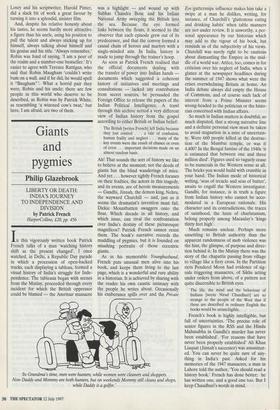Giants and pygmies
Philip Glazebrook
LIBERTY OR DEATH: INDIA'S JOURNEY TO INDEPENDENCE AND DIVISION by Patrick French HarperCollins, £20, pp. 456 In this vigorously written book Patrick French talks of a man 'watching history shift as the present changed'. I once watched, in Delhi, a Republic Day parade in which a procession of open-backed trucks, each displaying a tableau, formed a visual history of India's struggle for Inde- pendence. The tableaux began with scenes from the Mutiny, proceeded through every incident for which the British oppressor could be blamed — the Amritsar massacre was a highlight — and wound up with Subhas Chandra Bose and his Indian National Army sweeping the British into the sea. Because the eye formed links between the floats, it seemed to the observer that each episode grew out of its predecessor, and that the convoy formed a causal chain of heroes and martyrs with a single-minded aim. In India, history is made to jump through the trainer's hoop.
As soon as Patrick French realised that the official documents dealing with the transfer of power into Indian hands documents which suggested a coherent history of initiatives and meetings and consultations — lacked any contribution from secret sources, he persuaded the Foreign Office to release the papers of the Indian Political Intelligence. A trawl through this archive netted a very different view of Indian history from the gospel according to either British or Indian belief:
The British [writes French] left India because they lost control . . . a tale of confusion, human frailty and neglect . . . many of the key events were the result of chance or even of error . . . important decisions made on an almost random basis.
Ah! That sounds the sort of history we like to believe at the moment; not the deeds of giants but the blind wanderings of mice. And yet . . . however tightly French focuses on their frailties, the actors in this tragedy, and its events, are of heroic measurements — Gandhi, Jinnah, the demon king, Nehru, the wayward Churchill — and, just as it seems the dramatist's invention must fail, Dickie Mountbatten swaggers onto the float. Which decade in all history, and which issue, can rival the confrontation over India's destiny of these picturesque magnificos? Patrick French cannot resist them. The book's narrative records the muddling of pygmies, but it is founded on smashing portraits of those eccentric giants.
As in his memorable Younghusband, French puts unusual men alive into his book, and keeps them living to the last page, which is a wonderful and rare ability in a historian. It is achieved by sharing with the reader his own caustic intimacy with the people he writes about. Occasionally his exuberance spills over and the Private `In Grandma's time, men were hunters, while women were cleaners and shoppers. Now Daddy and Mommy are both hunters, but on weekends Mommy still cleans and shops, while Daddy is a golfer.' Eye/guttersnipe influence makes him take a swipe at a man he dislikes, writing, for instance, of Churchill's 'gluttonous eating and drinking habits' when table manners are not under review. It is unworthy, a per- sonal appearance by our historian which may add to the vigour of his book, but reminds us of the subjectivity of his views. Churchill was surely right to be cautious about dismantling the Empire in the mid- dle of a world war. Attlee, too, comes in for criticism over his neglect of India, when a glance at the newspaper headlines during the summer of 1947 shows what were the crises overwhelming Britain at home. An India debate always did empty the House of Commons, and of course such lack of interest from a Prime Minister seems wrong-headed to the politician or the histo- rian concerned with Indian affairs.
So much in Indian matters is doubtful, so much disputed, that a strong narrative line and a definite personal view must be taken to avoid stagnation in a mire of uncertain- ty. Were 660 people killed at the destruc- tion of the Mumbai temple, or was it 4,400? In the Bengal famine of the 1940s 'it is estimated that between one and three million died'. Figures used so vaguely cease to be numerals in the Western sense at all. The bricks you would build with crumble in your hand. The Indian mode of historical writing, 'seas of treacle and seas of butter', awaits to engulf the Western investigator. Gandhi, for instance, is in truth a figure from Indian history who cannot be acco- modated in a European rationale. His character and its contradictions, the traces of sainthood, the hints of charlatanism, belong properly among Macaulay's 'kings thirty feet high'.
Much remains unclear. Perhaps more unsettling to British authority than the apparent randomness of mob violence was the hint, the glimpse, of purpose and direc- tion behind it. In the Mutiny there was the story of the chapattis passing from village to village like a fiery cross. In the Partition riots Penderel Moon had evidence of sig- nals triggering massacres, of Sikhs acting under orders from above, of a pattern not quite discernible to British eyes.
The life, the mind and the behaviour of Indians [wrote Nirad Chaudhuri] are so strange to the people of the West that if these are described in ordinary English the books would be unintelligible.
French's book is highly intelligible, but full of uncertainties. The precise role of senior figures in the RSS and the Hindu Mahasabha in Gandhi's murder has never been established'. 'For reasons that have never been properly established' Ali Khan Liaquat (Jinnah's successor) was assassinat- ed. You can never be quite sure of any- thing in India's past. Asked for his memories of the 1947 massacres, a man in Lahore told the author, 'You should read a history book.' French has done better; he has written one, and a good one too. But I keep Chaudhuri's words in mind.


























































 Previous page
Previous page